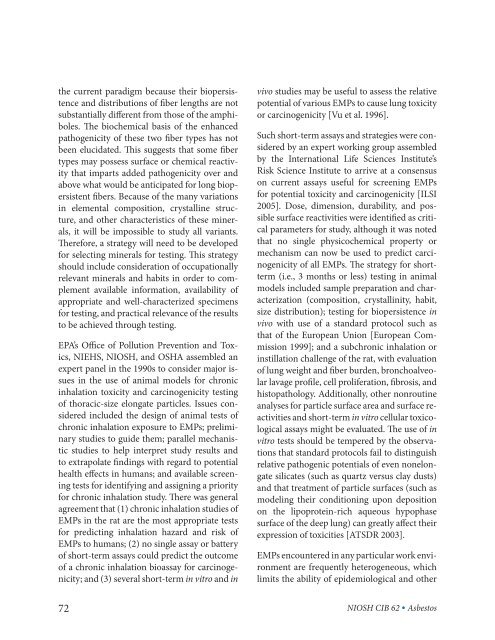Asbestos Fibers and Other Elongate Mineral Particles: State of the ...
Asbestos Fibers and Other Elongate Mineral Particles: State of the ...
Asbestos Fibers and Other Elongate Mineral Particles: State of the ...
- No tags were found...
Create successful ePaper yourself
Turn your PDF publications into a flip-book with our unique Google optimized e-Paper software.
<strong>the</strong> current paradigm because <strong>the</strong>ir biopersistence<br />
<strong>and</strong> distributions <strong>of</strong> fiber lengths are not<br />
substantially different from those <strong>of</strong> <strong>the</strong> amphiboles.<br />
The biochemical basis <strong>of</strong> <strong>the</strong> enhanced<br />
pathogenicity <strong>of</strong> <strong>the</strong>se two fiber types has not<br />
been elucidated. This suggests that some fiber<br />
types may possess surface or chemical reactivity<br />
that imparts added pathogenicity over <strong>and</strong><br />
above what would be anticipated for long biopersistent<br />
fibers. Because <strong>of</strong> <strong>the</strong> many variations<br />
in elemental composition, crystalline structure,<br />
<strong>and</strong> o<strong>the</strong>r characteristics <strong>of</strong> <strong>the</strong>se minerals,<br />
it will be impossible to study all variants.<br />
Therefore, a strategy will need to be developed<br />
for selecting minerals for testing. This strategy<br />
should include consideration <strong>of</strong> occupationally<br />
relevant minerals <strong>and</strong> habits in order to complement<br />
available information, availability <strong>of</strong><br />
appropriate <strong>and</strong> well-characterized specimens<br />
for testing, <strong>and</strong> practical relevance <strong>of</strong> <strong>the</strong> results<br />
to be achieved through testing.<br />
EPA’s Office <strong>of</strong> Pollution Prevention <strong>and</strong> Toxics,<br />
NIEHS, NIOSH, <strong>and</strong> OSHA assembled an<br />
expert panel in <strong>the</strong> 1990s to consider major issues<br />
in <strong>the</strong> use <strong>of</strong> animal models for chronic<br />
inhalation toxicity <strong>and</strong> carcinogenicity testing<br />
<strong>of</strong> thoracic-size elongate particles. Issues considered<br />
included <strong>the</strong> design <strong>of</strong> animal tests <strong>of</strong><br />
chronic inhalation exposure to EMPs; preliminary<br />
studies to guide <strong>the</strong>m; parallel mechanistic<br />
studies to help interpret study results <strong>and</strong><br />
to extrapolate findings with regard to potential<br />
health effects in humans; <strong>and</strong> available screening<br />
tests for identifying <strong>and</strong> assigning a priority<br />
for chronic inhalation study. There was general<br />
agreement that (1) chronic inhalation studies <strong>of</strong><br />
EMPs in <strong>the</strong> rat are <strong>the</strong> most appropriate tests<br />
for predicting inhalation hazard <strong>and</strong> risk <strong>of</strong><br />
EMPs to humans; (2) no single assay or battery<br />
<strong>of</strong> short-term assays could predict <strong>the</strong> outcome<br />
<strong>of</strong> a chronic inhalation bioassay for carcinogenicity;<br />
<strong>and</strong> (3) several short-term in vitro <strong>and</strong> in<br />
72<br />
vivo studies may be useful to assess <strong>the</strong> relative<br />
potential <strong>of</strong> various EMPs to cause lung toxicity<br />
or carcinogenicity [Vu et al. 1996].<br />
Such short-term assays <strong>and</strong> strategies were considered<br />
by an expert working group assembled<br />
by <strong>the</strong> International Life Sciences Institute’s<br />
Risk Science Institute to arrive at a consensus<br />
on current assays useful for screening EMPs<br />
for potential toxicity <strong>and</strong> carcinogenicity [ILSI<br />
2005]. Dose, dimension, durability, <strong>and</strong> possible<br />
surface reactivities were identified as critical<br />
parameters for study, although it was noted<br />
that no single physicochemical property or<br />
mechanism can now be used to predict carcinogenicity<br />
<strong>of</strong> all EMPs. The strategy for shortterm<br />
(i.e., 3 months or less) testing in animal<br />
models included sample preparation <strong>and</strong> characterization<br />
(composition, crystallinity, habit,<br />
size distribution); testing for biopersistence in<br />
vivo with use <strong>of</strong> a st<strong>and</strong>ard protocol such as<br />
that <strong>of</strong> <strong>the</strong> European Union [European Commission<br />
1999]; <strong>and</strong> a subchronic inhalation or<br />
instillation challenge <strong>of</strong> <strong>the</strong> rat, with evaluation<br />
<strong>of</strong> lung weight <strong>and</strong> fiber burden, bronchoalveolar<br />
lavage pr<strong>of</strong>ile, cell proliferation, fibrosis, <strong>and</strong><br />
histopathology. Additionally, o<strong>the</strong>r nonroutine<br />
analyses for particle surface area <strong>and</strong> surface reactivities<br />
<strong>and</strong> short-term in vitro cellular toxicological<br />
assays might be evaluated. The use <strong>of</strong> in<br />
vitro tests should be tempered by <strong>the</strong> observations<br />
that st<strong>and</strong>ard protocols fail to distinguish<br />
relative pathogenic potentials <strong>of</strong> even nonelongate<br />
silicates (such as quartz versus clay dusts)<br />
<strong>and</strong> that treatment <strong>of</strong> particle surfaces (such as<br />
modeling <strong>the</strong>ir conditioning upon deposition<br />
on <strong>the</strong> lipoprotein-rich aqueous hypophase<br />
surface <strong>of</strong> <strong>the</strong> deep lung) can greatly affect <strong>the</strong>ir<br />
expression <strong>of</strong> toxicities [ATSDR 2003].<br />
EMPs encountered in any particular work environment<br />
are frequently heterogeneous, which<br />
limits <strong>the</strong> ability <strong>of</strong> epidemiological <strong>and</strong> o<strong>the</strong>r<br />
NIOSH CIB 62 • <strong>Asbestos</strong>

















